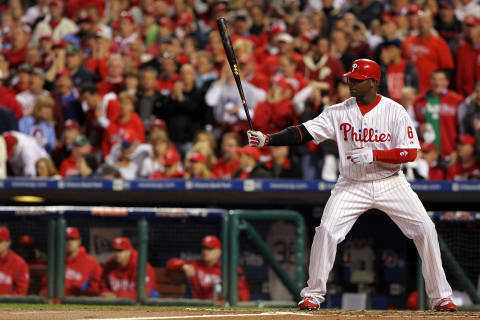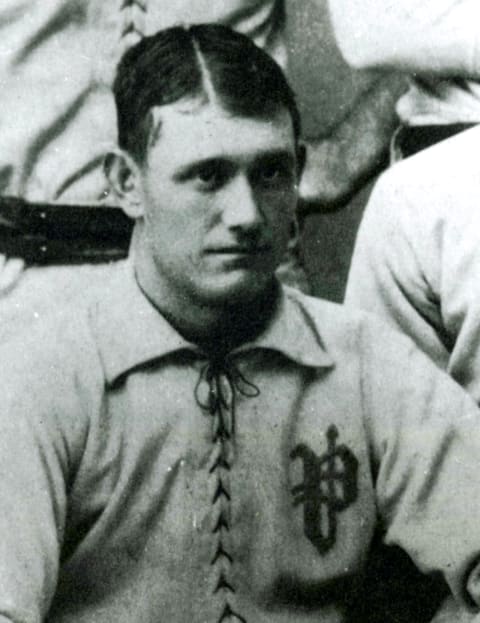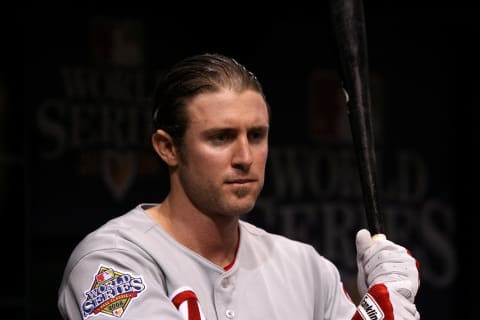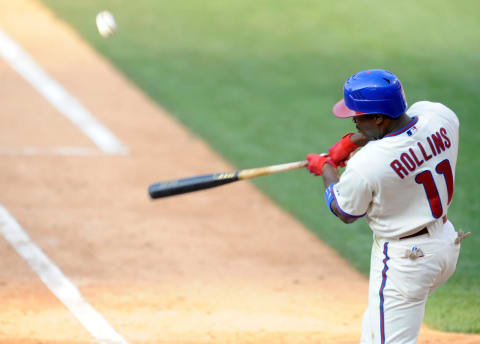Which Phillies should have their jersey number retired next?


Earlier this month, the Philadelphia Phillies bestowed Hall of Fame pitcher Roy Halladay with their highest honor when they retired his jersey. No member of the Phillies’ organization will ever wear number 34 again, instead, it will hang in Ashburn Alley directly between Steve Carlton’s 32 and Robin Roberts’ 36.
Whereas the New York Yankees are eventually going to run out of enough eligible numbers for players to wear if they keep retiring them at their current pace (the Bronx bombers have retired 22 jerseys including the number eight twice), the Phillies have only retired seven numbers. One (center fielder Richie Ashburn), 14 (pitcher Jim Bunning), 15 (third basemen Dick Allen), 20 (third basemen Mike Schmidt), 32 (Carlton), 34 (Halladay), and 36 (Roberts).
Additionally, the franchise has also honored pitcher Pete Alexander and outfielder Chuck Klein, though both pre-dated jersey numbers and are represented with a large “P” instead. The number 42 is also retired across Major League Baseball in honor of Jackie Robinson.
When the Phillies retired Allen’s 15 last September, he became the first member of the franchise to have his number retired before being inducted into the Hall of Fame. The decision was definitely the right one, but it also signaled an interesting change in regards to which players they might honor going forward.
With the organization’s qualifications opening up to other players who have left a seismic impact on the franchise, I began to think about some players throughout team history who should one day have their jersey retired. Here are four Phillies who deserve to be honored out in Ashburn Alley:
4. Ryan Howard
One of the greatest power threats of his generation, and a key part of the 2008 World Series team, Ryan Howard was an instrumental piece of the greatest teams in Phillies’ history. He also hammered his way to an impressive number of accolades that set him apart from so many players who also donned red pinstripes.
Howard burst onto the scene in 2005 hitting .288/.356/.567 with 22 home runs and 63 RBIs in just 88 games. He went onto win NL Rookie of the Year honors that season and his performance turned so many heads that it convinced the Phillies to trade future Hall of Famer Jim Thome to the Chicago White Sox that offseason. That trade cemented Howard as the team’s unquestioned full-time first basemen and unleashed him on an unprecedented run of power hitting.
Howard followed up his rookie season by hitting a franchise-record 58 home runs with 149 RBIs. He would go on to win the 2006 NL MVP award and the Home Run Derby, cementing himself as arguably the pre-eminent power threat of his generation.
Howard still holds the distinction of being the fastest player in MLB history to 100, 200, and 250 career home runs by games played. He currently ranks as the second-fastest player in the history of the sport to 300.
Phillies’ 1B Ryan Howard was arguably the best power hitter of his era
From his MVP season in 2006 through 2012, no player in Major League Baseball had more home runs than Ryan Howard. The next closest player, Albert Pujols had just two fewer but he hit them in 78 more games.
In fact, from 2005 until his final season in the major leagues, 2016, Howard’s 380 home runs ranked fourth in all of baseball. A miraculous feat considering that injuries severely derailed him at the end of his career. The three players ahead of him Pujols (431), David Ortiz (411), and Miguel Cabrera (401) each played between 122 and 296 more games than Howard over that same time.
It’s hard not to think about what could have been if injuries didn’t start to get the better of Ryan Howard. After blowing out his Achilles on the final play of the 2011 NLDS, he would play in more than 130 games just once before his retirement.
Towards the end of his time in Philadelphia, Howard started to bear the brunt of the fan bases’ frustration with the team. Limited availability, poor play, and an albatross contract made him an easy target.
However, none of that should hamper what he was able to accomplish during his time in Philadelphia. He was indisputably one of the greatest power hitters of his era and the heart of the lineup for many of the best teams the franchise ever had.
He currently ranks in the top 10 in Phillies history in a number of highly valued categories including; games played (seventh) slugging percentage (sixth), extra-base hits (fourth), intentional walks (second), win probability added (second), at-bats per home run (second), and of course home runs (second).
He also holds the franchises’ post-season records for doubles, extra-base hits, and RBIs. Oh, and he owns the Phillies’ record for career grand slams. Howard’s number six should rightfully hang in Ashburn Alley.

3. Ed Delahanty
When you’ve been a professional baseball franchise for as long as the Philadelphia Phillies have, you are sure to have had some storied players wear your cap. Whether it’s from the live or dead-ball era, there has been no shortage of spectacular players who have played for the Phillies and have been among the best the sport has ever seen. One of them was Ed Delahanty.
Delahanty had a Hall of Fame career across two stints with the Phillies. The first lasted just 130 games throughout the 1888 and 1889 seasons. He then left to play for the Cleveland Infants of the now-defunct Players’ League before returning to the National League and Philadelphia in 1891. He would stay with the Phillies until he left for the Washington Senators in 1902, playing in the eighth-most games in franchise history.
Ed Delahanty was a five-tool player for the Phillies in the dead-ball era
One of the greatest pure hitters of all time, Delahanty had a career batting average of .345 which currently ranks eighth all-time among major leaguers. He managed to hit over .400 three different times on his way to two batting titles, but he could do much more than just make contact.
Delahanty had some great power for his era. In 1893 he managed to slug an NL leading 19 home runs. Just for context, this was nine more home runs than the St. Louis Browns ball club hit all year, and as many as the Louisville Colonels had that season. He also had a knack for driving runs in, Delahanty’s 1,288 RBIs still rank second in team history.
He was a genuine five-tool player and he even led the NL in stolen bases with 58 in 1898. The production that Delahanty was able to give the Phillies was incredible for his era and remains impressive today.
Considering Delahanty played in an era before players wore numbers on the back of their jerseys, he doesn’t have one to be retired. That shouldn’t be an issue though. Instead, the Phillies can honor him the same way they have Pete Alexander and outfielder Chuck Klein, with a script “P” above the Alley Store in Ashburn Alley.

2. Chase Utley
Has there ever been a player more embraced by the Philadelphia faithful than Phillies’ second basemen Chase Utley? From his first major league hit, a two-out grand slam, all the way to his final at-bat in red pinstripes Utley wasn’t just a fan favorite, he was the stuff of legends in Philly.
Phillies fans can talk on and on about Utley’s heart, his hustle, and his drive to win. The player affectionately dubbed “The Man” by Harry Kalas, only knew one way to play the game and it was at 110%. But there is actually a pretty compelling case for Utley to have his number retired that isn’t just tied to those intangibles that your Dad loves to talk about so much.
Look up the Phillies’ all-time leaderboards and you’ll frequently see Utley’s name towards the top. He’s 10th in walks (625), ninth in games played (1,551) and hits (1,623), sixth in home runs (233) and runs scored (949), and fifth in doubles (346). Utley’s 173 hits by pitches are nearly double that of the next closest player, catcher Mike Lieberthal (88).
Utley also passes the analytics test too. He’s sixth in Win Probability Added (26.4) and currently ranks second in franchise history for position player WAR (62.0) and defensive WAR (17.7) trailing only Hall of Famer Mike Schmidt in both.
Chase Utley always found another gear in the postseason
When the games mattered most, Utley generally found a way to kick it into another gear. His seven World Series home runs are the most in history for a second baseman. The five dingers he crushed during the 2009 series tied him with Yankees legend Reggie Jackson for the most homers in a single World Series.
When Sports Illustrated created their All-Decade team for the 2000s, Chase Utley was rightfully their starting second baseman. There’s a pretty strong argument to be made that Utley was the best second baseman of his era and that he should ultimately be rewarded with a plaque in Cooperstown.
The Phillies can only control what they can do though, and what they should do is retire his number 26 as soon as possible.

1. Jimmy Rollins
It’s possible that no player is more synonymous with the 2008 world champion Philadelphia Phillies team than shortstop Jimmy Rollins. If there were to be only one player from that team who ends up being honored with their number hanging in Ashburn Alley one day, I’d bet good money that it would be Rollins, the franchise all-time hits leader.
When Jimmy Rollins passed Mike Schmidt to become the Phillies’ hit king, he managed to accomplish the feat in 389 fewer games, and in some ways, it almost felt inevitable. Throughout his 15 years in Philadelphia, Rollins had been the heart and soul of the best era of Phillies baseball.
Rollins ranked in the top three in a host of offensive categories including hits (first), doubles (first), at-bats (first), total bases (second), extra-base hits (second), stolen bases (second), triples (third), singles (third) and runs scored (third). He also ranks fourth in defensive WAR, sixth in position player WAR, and ninth in home runs.
Jimmy Rollins was at his best in 2007 when he won NL MVP and sent the Phillies to the playoffs
During his best offensive season in 2007, Rollins won National League MVP honors (along with a Silver Slugger and a Gold Glove), while hitting .296/.344/.531 with 30 home runs, 41 stolen bases, and a league-leading 20 triples. He proudly declared the Phillies were the team to beat in the NL East and made good on his comments.
That season he also became the last player to join the ultra-exclusive 20-20-20-20 club. Over the course of his career, Rollins also smacked an incredible 46 leadoff home runs in his career, good for sixth all-time and second-most ever for a hitter in the National League.
In addition to his standings on the Phillies’ all-time leader boards, he boasts some impressive accolades. He has won four Gold Gloves, and a Silver Slugger in addition to winning National League MVP in 2007. Rollins was also named an All-Star three times.
Jimmy Rollins was indisputably one of the greatest Phillies in franchise history, and he should have his number 11 retired sooner rather than later.